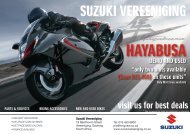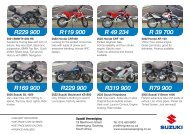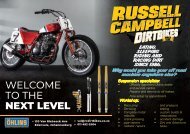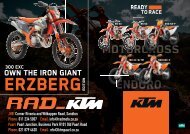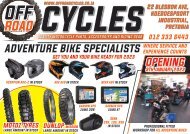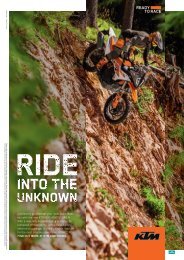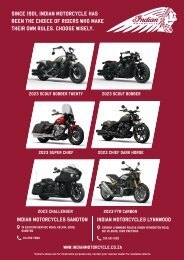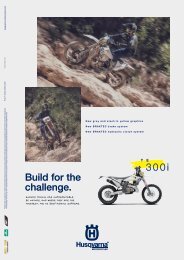Create successful ePaper yourself
Turn your PDF publications into a flip-book with our unique Google optimized e-Paper software.
DON’T ‘BRAKE’ A SWEAT<br />
Increasing the number of pistons increases the swept piston<br />
area, allowing for longer, narrower brake pads and smaller discs.<br />
Caliper mounting …<br />
Axially mounted caliper<br />
Front fork leg mounted brake calipers, also called axially<br />
mounted. Early disc brake calipers were in front of the fork leg<br />
on top of the disc. This placed the caliper in an area of high air<br />
flow for better cooling.<br />
Calipers on most modern motorcycles are now mounted to the<br />
rear of the fork leg.<br />
This reduces the angular momentum of the fork assembly and<br />
improves low speed handling.<br />
Radial mounted calipers:<br />
A radial brake caliper is mounted parallel to the forward direction<br />
on the braking system, making them more rigid than the<br />
traditional axial mount, and not prone to torsional flexing. The<br />
lack of slight lateral movement allows more precise braking and<br />
crisper feeling brakes.<br />
Inboard brakes<br />
Honda tried an inboard brake design on a few models such as<br />
the VF400F and CBX550F, but reverted to the standard layout.<br />
The intent was to improve wet weather performance and have<br />
a cleaner appearance. The front brake assembly with vented<br />
discs was enclosed in a vented aluminium hub and the caliper<br />
was mounted onto the hub and gripped the disc from the<br />
outside. This kept the brake assembly dry and allowed the use<br />
of cast iron ventilated discs because the shrouding covered any<br />
unsightly surface rust on the disc. The system would prove to be<br />
short lived with all successive models reverting to the standard<br />
uncovered layout.<br />
Perimeter brakes<br />
Buell Motorcycle Company adopted a rim-mounted disc brake<br />
that was said to reduce unsprung weight in the wheel-brake<br />
system, allowing lighter wheel spokes. This style is generically<br />
termed a “perimeter brake” for its point of attachment to<br />
the wheel, and had been used in smaller numbers by other<br />
manufacturers before Buell.<br />
Single piston Caliper<br />
Double piston Caliper<br />
Rubber vs Steel braided brake lines …<br />
Most stock bikes come with rubber brake lines – and there is<br />
nothing inherently wrong with them – or else the manufacturer<br />
would not fit them. But over time, albeit a long time, they do<br />
degrade and break down. Also, they are rubber so they flex and<br />
expand a bit. Especially when things heat up.<br />
Visually you can sometimes see when they start to wear; you’ll<br />
notice little cracks on the exterior. When you flush or change<br />
your brake fluid (Yup you need to do that sometimes…)<br />
The fluid, instead of being translucent goes dark and looks<br />
almost muddy. That’s the rubber breaking down. Whilst they<br />
should not explode, on older bikes little bits have been known to<br />
come adrift inside and clog the works.<br />
Braided or steel brake lines:<br />
Aside from looking mighty trick (you can even choose a colour),<br />
the general consensus is that braided brake lines are a better<br />
option because they generally last a lifetime. They do not flex<br />
or expand which means better brake feel. The lines are stronger<br />
– particularly for off-road use when you donner into rocks and<br />
stuff.<br />
Replacement braided hoses are pretty common and not too<br />
pricey – just chat to your dealer.




